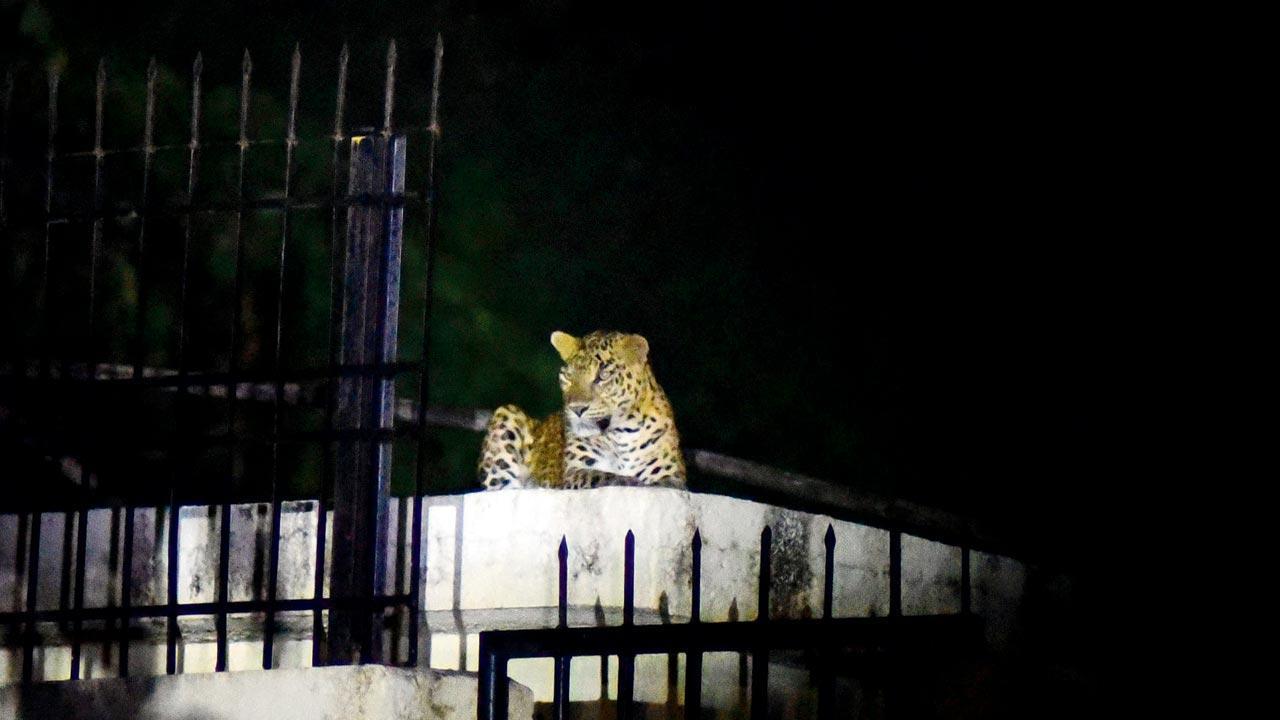Green Oscar awardee Sanjay Gubbi’s new book emphasises his favourite cat’s place in the ecosystem threatened by infra development

SGNP’s resident leopard, Venus, pictured at Aarey Milk Colony in October 2019. The female leopard remained at the resting spot for almost two hours. Pic/Ashish Rane
Sanjay Gubbi is no stranger to leopard conservation. Originally from Tumkur district, Karnataka, he spent his high school years in the rocky outcrops and scrub forests. “This is where I got a chance to learn, appreciate and understand the larger aspects of this cat, which immensely fascinated me,” shares the Bengaluru-based scientist and conservationist. In February 2016, a direct face-off with a leopard, which had entered a school in his home city, had left Gubbi severely wounded, with a bit of his right humerus—a long bone in the arm that runs from the shoulder to the elbow—chipped off. “Having faced its mammoth power, especially the canine bite, has made me realise how powerful these animals are. I felt like a prey animal when the leopard was holding my right arm in its mouth and clawing me all over.” His admiration for the animal, he says, has only grown since then, and made him feel more committed to its protection.
ADVERTISEMENT
Leopards, says the author, are one of the most beautiful wild cats in the world that are found in 63 countries. Pic courtesy/Sudhir Shivaram
His new book, Leopard Diaries: The Rosette In India (Westland), takes readers into the wild, to understand what makes this creature—distinctly different-looking from other spotted cats like the cheetah and jaguar—such an important part of the ecosystem, not just in India, but across the globe. The leopard is currently categorised as “vulnerable” in the International Union for Conservation of Nature’s Red List. While the Centre’s report ‘Status of leopards in India, 2018’ mentioned a minimum number of 12,852 leopards in the country, Gubbi says this is an underestimate by at least 40 per cent. “This study focused mostly on forested habitats where tigers are found, as it was a by-product of the all-India tiger estimate. Hence, other leopard habitats such as rocky outcrops, smaller dry forests, higher elevation habitats in the Himalayas, agricultural landscapes [coffee, tea, areca nut, sugarcane plantations] where leopards are known to be found in good numbers are not part of this exercise. Similarly, a majority of Northeast India was excluded from the study,” he says in an email interview. Irrespective, the figures don’t seem promising, especially with the increasing encroachment of green patches for development and infra projects.
Gubbi was injured by a leopard at a school in Bengaluru during its rescue operations in February 2016. Pic courtesy/Anantha Subramanyam
While Gubbi has spent many hours in the deep forests of Karnataka tracing the animal’s movement, he is equally invested in understanding its relationship with other regions, especially metropolitan cities like Mumbai, which is home to the Sanjay Gandhi National Park (SGNP). Gubbi says that SGNP—at last count, home to 47 leopards—is a thriving habitat, because it is connected to Tungareshwar Wildlife Sanctuary and other forest patches. “This forms a large leopard habitat of over 600 square kilometres [1,48,000 acres],” he says. “But, some parts of this large wildlife habitat are becoming fragmented and getting converted to narrow corridors due to the Golden Quadrilateral project, industries and housing development, etc.” Gubbi says now, more than ever, there is an urgent need to focus on protecting these areas, conserving the corridors and finding suitable mitigation measures to make infrastructure leopard-friendly.
Sanjay Gubbi
Not doing anything about it could, however, mean a territorial overlap, which in turn, could lead to more conflicts. “This increases the animosity of people towards leopards, negatively impacts the opinion of policymakers towards the species, increases the risk of assault to the frontline staff of the forest department, and causes many other indirect problems. People will also demand translocation of leopards, or may even take law into their own hands, increasing retaliatory killing. It is a serious pinch point for leopard conservation,” says Gubbi, who won the Whitley Award, popularly known as the Green Oscars, in 2017.
He discusses a recent study conducted by a group of wildlife researchers who had radio-collared two leopards from SGNP. One of them—a male leopard, around six to eight years old—had travelled 62 km in six days, moving between SGNP and Tungareshwar sanctuary thrice, crossing a busy highway and even railway track. “Unfortunately, a popular narrative has been floated in India that leopards can survive well in small, human-created landscapes such as sugarcane and maize fields, and arecanut plantations. Though some leopards are indeed present in such landscapes, they are constantly threatened by vehicular collision, mortality due to snares, human-leopard conflict and other threats.”
He points to his own radio-collaring data from Karnataka, which showed that leopards need to move over vast areas. “One leopard that I had radio-collared used an area of 141 square km, nearly the size of Solapur city. Now, this new data from radio-collaring in SGNP highlights that leopards also need vast natural spaces, and potentially face severe threat … hence, we need to move away from the popular notion that leopards will ‘happily’ survive well in small, human-created leopard habitats. Natural habitats are extremely important for long-term survival of leopards in India and elsewhere.”
‘Leopards saving up to 90 lives per year in Mumbai’
A recent study suggests that leopards might help prevent rabies, as they largely consume pye-dogs. The study showed that leopards could be saving up to 90 human lives per year in Mumbai alone by consuming stray dogs. Another example of the ecological importance of leopards is their role in controlling wild pig populations, which use many of the same plant foods as humans, turning them into key crop raiders.
 Subscribe today by clicking the link and stay updated with the latest news!" Click here!
Subscribe today by clicking the link and stay updated with the latest news!" Click here!






